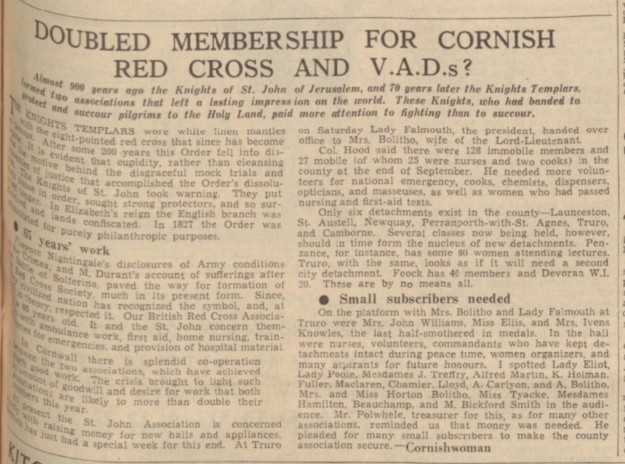
Doubled membership for Cornish Red Cross and VADs [Voluntary Aid Detachment nurses]
Western Morning News 2nd November 1938
Former WW1 Nurse or VAD, Miss M.P. Tyacke is mentioned amongst the guests of this meeting combining Red Cross and St John’s Ambulance volunteers, no doubt in preparation for future war in the months after the Munich Crisis of September 1938. The WW1 network of nurses, hospital staff and first aid volunteers was being rebuilt.
“Colonel Hood said there 128 immobile members and 27 mobile (of whom 25 were nurses and two cooks) in the county at the end of September [1938].
He needed more volunteers for national emergency, cooks, chemists, dispensers, opticians, and masseuses, as well as women who had passed nursing and first aid tests.”
“Only six detachments exist in the county – Launceston, St. Austell, Newquay, Perranporth with St. Agnes, Truro and Camborne.
Several classes now being held, however, should in time form the nucleus of new detachments. Truro [with 80] looks as if need a second city detachment.
Feock has 40 members and Devoran W.I. 20 [members] …
“In the hall were nurses, volunteers, commandants who have kept detachments intact during peacetime … I spotted … Miss Tyacke … in the audience.”
Devoran Village Hall was the site of many Red Cross training activities during wartime and postwar (organised postwar by Miss Audrey Webber?)
There was obviously an overlap of women between the Red Cross detachment and the Devoran W.I. which used (and helped found) Devoran Village Hall.

In the 1939 Register for Devoran (similar to a census), several women who were former WW1 VADs and nurses like Miss Tyacke are listed as part of the civilian nursing reserve for wartime and ARP help. Worthy of another future blog post.
Several more VAD names and Civilian Nursing Reserve women from Devoran village are mentioned in my churchyard blog post here: https://devoranwarmemorial.wordpress.com/2020/06/22/devoran-churchyard-headstones-connected-to-ww1-and-ww2/
Blog post by Mark Norris as part of DVH 100, 19 April 2024


